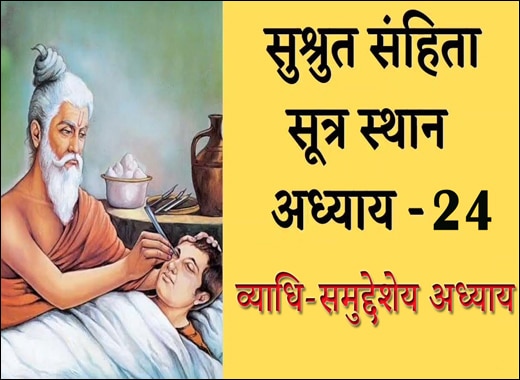Vyadhi-Samuddesheeya Adhyaya – 24th Chapter of Sushruta Samhita
Abstract
Vyadhi Samuddesheeya Adhyaya deals with the classification of diseases which are according to their specific type of nature. This chapter is well explained in Susrutha Samhita a treatise which is one of the most important foundational texts in Ayurveda. Sushruta Samhita is an ancient Sanskrit text because it includes surgical training, the various procedures which are mainly followed by modern surgery facts. The Kaiser Library in Nepal holds one of the earliest palm-leaf manuscripts of the Sushruta Samhita. The Suruta-samhita is thought to have been known to the scholar Dhabala (fl. 300–500 CE), which yields the latest date for the form of the work that has survived into the contemporary period. The Suruta-samhita has been the subject of much scholarly study, much of which is based on versions of the text that were released in the late nineteenth and early twentieth century. The Sushruta Samhita, which is still in existence, is divided into 186 chapters and describes 1,120 ailments as well as 700 therapeutic herbs, 64 mineral preparations, and 57 preparations derived from animal sources. Further in this article, we are going to discuss the knowledge of diseases and their specific nature of the disease.

Introduction
Susruta Samhita is the father of Surgery, In Rigveda and Atharavaveda which has been referenced for both health and diseases. Charak Samhita, Susruta Samhita and Ashtanga Hridya are the three classics which are further classified into the eight branches-Surgery, Ear, Nose, Throat and the various supernatural diseases which are Therapeutics, Paediatrics and rejuvenation. There are 6 sections of Susruta Samhita-
- Sutra Sthana – It is the origin of medicine and treatment and provides advice to Vaidyans.
- Nidana Sthana – Which tells about pathology
- Sharira Sthana – Tells about the anatomy of the human
- Chikitsa Sthana – There is a special method of treatment
- Kalpa Sthana – Tells about the preparation of medicines
- Uttar Sthana – Tells about the various disorders of the eye, Nervous system and overall health.
There are various concepts of Shalya Tantra which includes Rhinoplasty, removal of the dead foetus and the process of lithotomy. Ayurveda has a long tradition which first originated in India 3000 years ago.
1. Vyadhi Bheda (Various kinds of diseases)- There are two types of diseases
- Shastrasadhya – These diseases are treated with various sharp instruments and are curable by surgery.
- Snehadikriyasadhya – These diseases are treated using therapy such as Oleation therapy (sudation (swedana), emesis (Vamana), Purgation (Virechana) and Enema (Basti) and other nasal medications (Nasya).
2. Definition Of Vyadhi And Trividha Dukha
In Susruta Samhita, the diseases which are affecting the person have been described in detail in every branch of Ayurveda. This is known as Vyadhi (Misery) which hurts the man and is well explained in the First Chapter. There are mainly three of Vyadhi (misery) –
- Adhyatmika (Psychosomatic) – It is related to one’s own body, mind and sense organs.
- Adhibhautika (Traumatic) – It is related to various living beings (Animals, Insects, Birds and various other microorganisms).
- Adhidaivika (Natural) – It is related to supernatural powers (God, Demon, Rain, Lightening).
3. Saptavidha Vyadhi – There are 7 types of vyadhi
- Adibala Pravritta – It is produced by the strength of the origin
- Janmabala Pravritta – It is by the strength of the birth
- Doshabala Pravritta – Produced by the strength of the doshas
- Sanghatabala Pravritta – It is produced due to assault
- Kalabala Pravritta – It is produced due to the strength of time and season
- Daivabala Pravritta – It is due to the supernatural powers of the human beings
- Svabhava Bala Pravritti – Due to the strength of the natural events
4. Symptoms Of Adhyatmika Vyadhi (Disease of one’s individual)
- It has hereditary anomalies that are produced by the various abnormalities of Sukra (semen) and Shonita (menstrual blood). For example- kustha (leprosy) and arsh (piles). This is known asAdibala Pravritta disease. It is of two types – Matruja (derived from mother) and Pitruja (derived from father).
- Janambala Pravritta Vyahdi – This is due to improper conduct of the mother or due to improper antenatal care (at the time of birth). For example- Lameness, Congenital blindness, Dumb, Nasal twang in the voice and Dwarf. This disease is also of two types – Rasakruta (produced by rasa dhatu) and Dauhrdapachara kruta (which is created as a result of the mother’s unmet desires during pregnancy).
- Doshbala Pravritta Vyadhi – This disease is due to improper intake of food and other various activities which are known as Doshbala Pravritta Vyadhhi. There are two types – Amashaya Samutta (which is produced in the stomach and the part of the small intestine) & Pakvashaya Samuttha (which is produced and is born in the part of the large intestine). This is of another two types- Sarira (part of the body) and Manasa (of the mind).
5. Symptoms Of The Adhibhautika Vyadhi – Due to diseases of the external objects
Sanghata Bala Pravritti Vyadhi (it is caused by external or accidental causes), which is caused by the assault of a vital person on a weak person.
- This is of two types – Shastrakruta (caused by the weapons) and Vyala Krta (caused by the attack of wild animals).
6. Symptoms Of Adhidaivika Vyadhi
- Kalabala Pravritta Vyadhis – It is produced due to seasons (kala) such as Cold, Heat, Wind, Sunlight which are known as Kalabala Pravitta Vyadhis. This disease is of two types- Vyapanna Rtu (abnormality of seasons) and Avyapanna Rutu Kruta (produced due to normal seasons).
- Daivabala Pravritta Vyadhis – This is caused due to various supernatural agencies, curses of the sages, the performance of the harmful spiritual sites or can be due to infection (developing the disease from another disease person) is known as Daivabala Pravritta Vyadhi. There are two types – Vidyudasani Krta (produced by lightning and thunder) and Pishachadi Krta (produced due to demons or evil spirits). Again these Vyadhi are of two types – Samsargaja (produced due to close contact or infections) and Akshamika (idiopathic).
- Svabhavabala Pravritta Vyadhi (Physiological) – This disease is produced due to Hunger, thirst, Old age and Sleep. There are two types- Kalaja (appear at the proper time) and Akalaja (at a delayed time).
Sarva Vyadhi Karana
- Vata, Pitta and Kapha are the leading root cause of any disease because of their features with results that are observed during the cure.
- In the Universe without the involvement of Satva, Rajas and Tamas cannot be without the involvement of Vata, Pitta and Kapha doshas.
- Due to the involvement of different dhatus (tissues), Malas (excreta) and Doshas different types of diseases are seen.
- Due to the vitiation of doshas, the diseases are given different names that are Rasaja (the disease which is born due to Rasa tissue), Sonitaja (disease due to blood), Mamsaja (the disease which is due to muscles), Medoja (which are from fat), Majja (The diseases which are born from bone marrow) and Sukraja (from semen).
Dhatu Vikara Rogas
Diseases of each Dhatu
1. Rasadoshaja Vikara (Diseases which are produced due to vitiated Rasa Dhatu) which include-
- Anorexia
- Indigestion
- Anaemia
- Obstruction
- Emaciation
- Bad breath in the mouth
- Wrinkles
- Grey hair
- Lassitude
- Diseases of the heart
2. Raktadoshaja Rogas (Due to vitiated rakta dhatu) which include-
- Leprosy
- Furunculosis
- Pigmented naevus
- Alopecia
- Congenital capillary haemangioma
- Gout
- Piles
- Splenomegaly
- Pigmented moles
- Menorrhagia
- Bleeding disorders and various ulceration in the anal and penial region
3. Mamsadoshaja Vikara (when vitiated due to muscles)
- Excess growth of the muscles
- Malignant tumour
- Adenoids
- Enlargement of the Uvula
- Galaganda (goitre)
- Inflammation of the lips
- Salivary Cyst
- Gingivitis
4. Medodoshaja Vikara (The diseases which are due to Fat tissue)
- Tumours
- Hernia
- Diabetes mellitus
- Profuse sweating
- Malignant tumour
- Enlargement of the lips by fat
5. Asthi Doshaja Vikara (Caused due to vitiated bone tissue)
- Extra growth of tissues
- Bone Pain
- Distorted shape and texture of the nail
- Pricking sensation in the bone region
- Eruption of extra tooth
6. Majja Doshaja Vikara (diseases which are caused due to vitiation of Bone marrow)
- Darkness in front of the eyes
- Fainting
- Giddiness
- Conjunctivitis
- Formation of ulcers in the joints of fingers
- Increase the size of bony joints
7. Sukra Doshaja Vikara (produced due to vitiation of semen)
- Impotence
- Seminal Calculus
- Spermatorrhea
- No desire for sex
8. Malayantana Doshas (Due to waste products)
- Various diseases of the skin
- Improper flow of the waste
- Excessive excretion
- Irregular excretion
9. Indriyatana Doshas (Doshas of sense organs)
- Improper Perception of the sense organs
Vyadhi Utpatti Sthan And Srotovaigunya (Place of origin of disease)
- The Vitiated Doshas circulate in the body and when this dosha gets obstructed it leads to various abnormalities in the channels and aggravates the doshas.
- Where the doshas are aggravated is where the sickness appears.
Doshas – Vyadhi Sambandha (Relation between doshas and disease)
- There is a great debate about the relation between vata dosha and fever. Is it permanent or is it a temporary one? If we say that the relationship between them is permanent then all the living beings will be sick all the time.
- If the relationship between the doshas and diseases is permanent and long-standing due to the presence of Vata doshas.
- Doshas and diseases are present in different places because the symptoms that are present are not going to appear in any other place.
Doshas Vyadhi-Sanleksh Nemitak
- Due to the above-mentioned, it is said that fever (disease) will not happen without the involvement of doshas (vata doshas).
- This relationship is not permanent between doshas and diseases.
- Such as lightning, wind and rain cannot be seen without the sky and the sky is present all the time but lightning is not seen all the time.
- But when the sky gets a suitable time and some exciting causes the lightning will be seen in the sky.
- Similarly, the bubbles of water and the waves are not seen elsewhere but seen only in the water.
- This shows that the water bubbles and waves do not appear in water all the time, but it is seen in particular times with some causes.
- So, the relation between Vata (doshas) and Fever (disease) is neither associated or dissociated. Hence the origin of disease is due to certain causes of food and various other activities.
Conclusion
Sushruta Samhita is an ancient Sanskrit text because it includes surgical training, the various procedures which are mainly followed by modern surgery facts. The Kaiser Library in Nepal holds one of the earliest palm-leaf manuscripts of the Sushruta Samhita. Vyadhi Samuddesheeya Adhyaya deals with the classification of diseases which are according to their specific type of nature. Further, we studied various types of disease in detail in this article.
{“background_image_attachment”:false,”background_display”:”tile”,”background_image_size”:”full”,”background_image_opacity”:”100″,”border_thickness”:”1px”}”>[siteorigin_widget class=”WP_Widget_Custom_HTML”][/siteorigin_widget]



